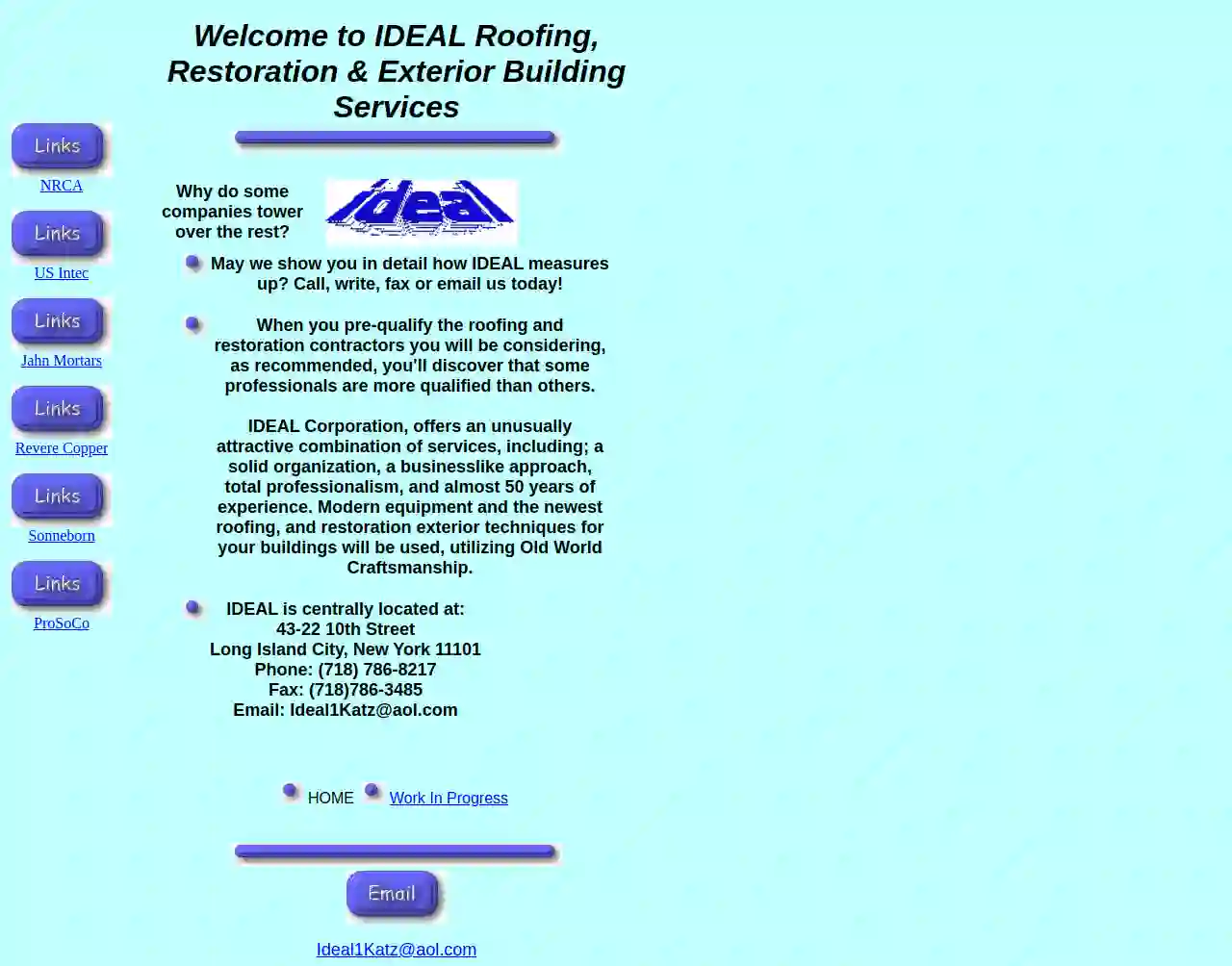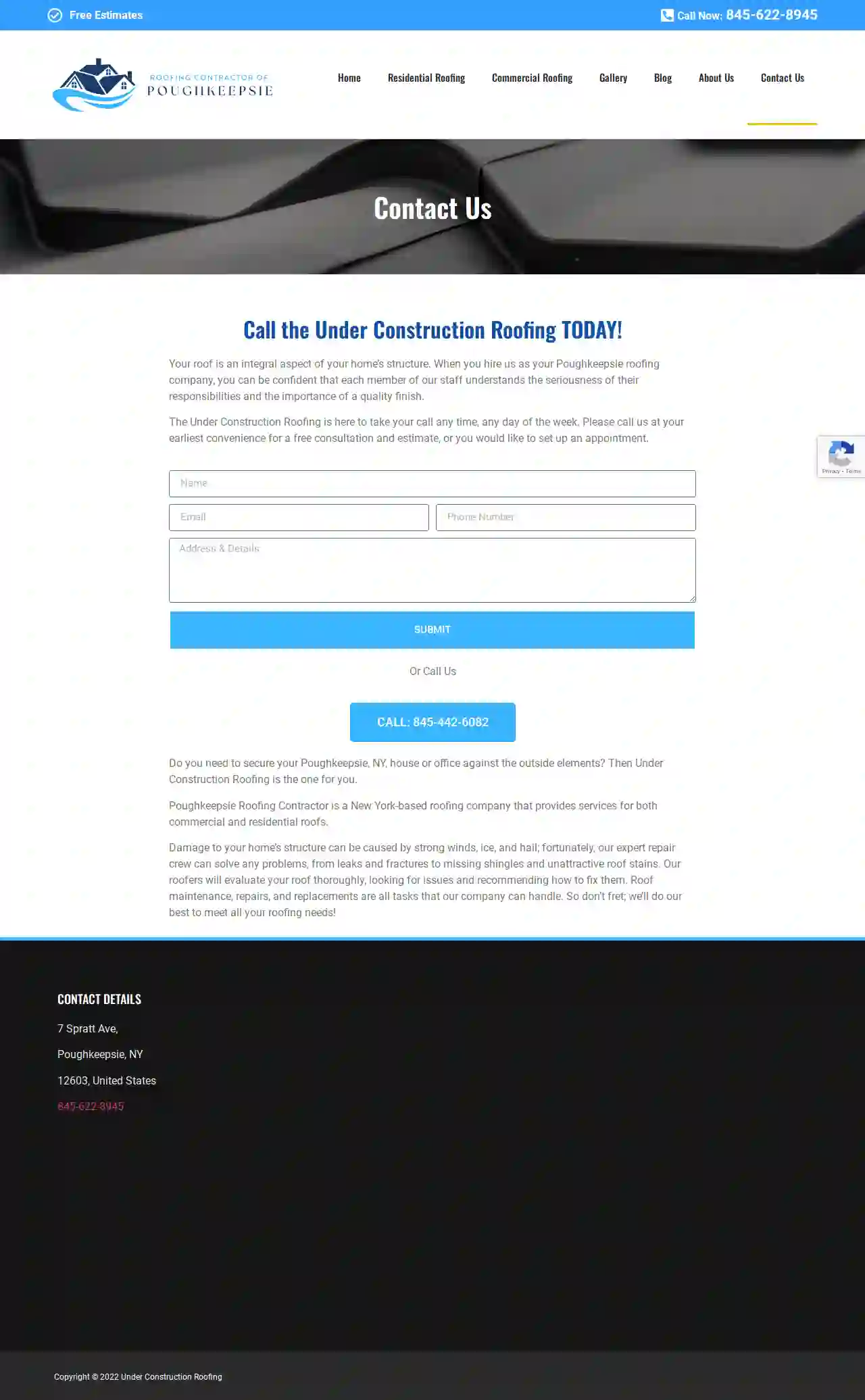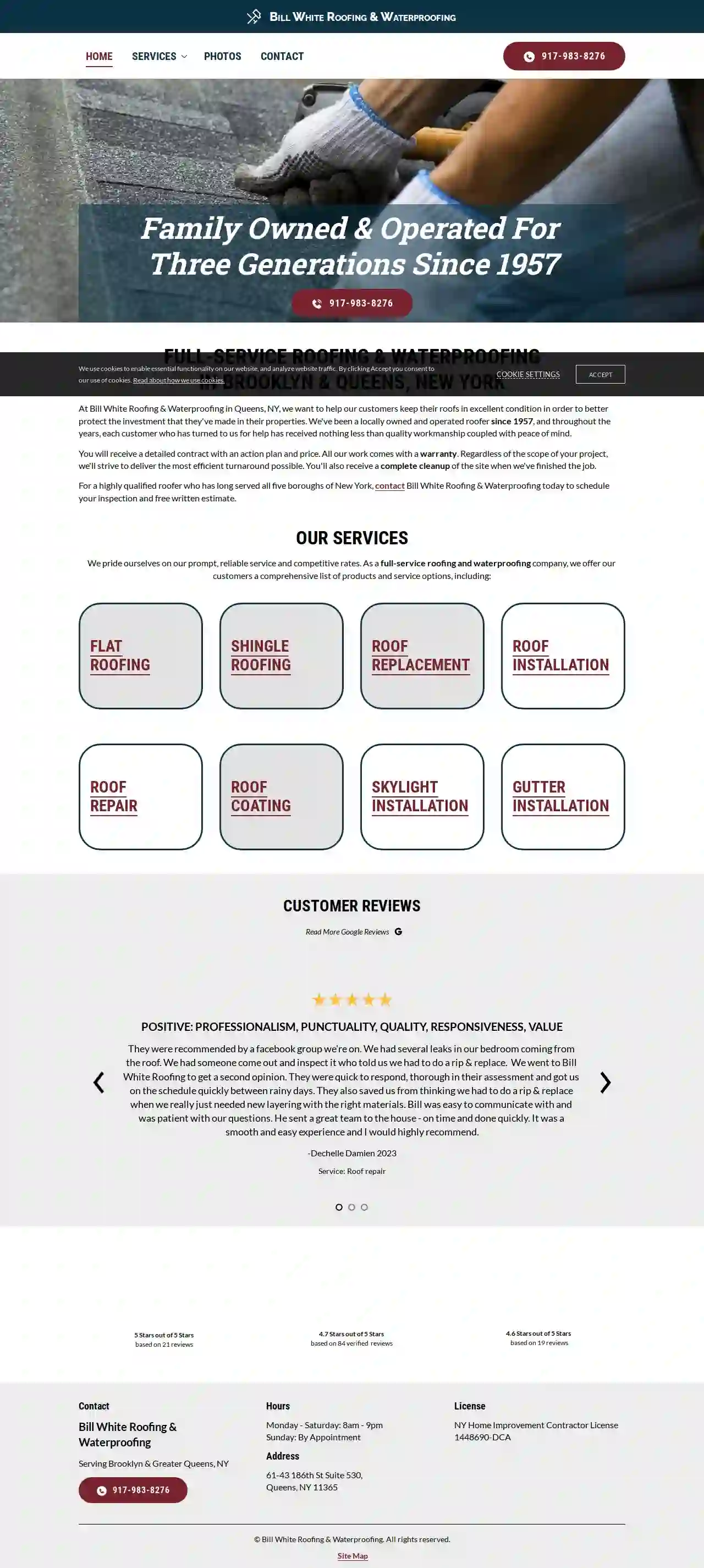Roofing Companies New Windsor
Find the best Roofing Service in New Windsor
Get 3 FREE Roofers quotes for your project today! Compare profiles, reviews, accreditations, portfolio, etc... and choose the best deal.

Ideal Roofing & Sheet Metal
51 reviews43-22 10th Street, Long Island City, 11101, USWelcome to IDEAL Roofing, Restoration & Exterior Building Services Why do some companies tower over the rest? May we show you in detail how IDEAL measures up? Call, write, fax or email us today! When you pre-qualify the roofing and restoration contractors you will be considering, as recommended, you'll discover that some professionals are more qualified than others. IDEAL Corporation, offers an unusually attractive combination of services, including; a solid organization, a businesslike approach, total professionalism, and almost 50 years of experience. Modern equipment and the newest roofing, and restoration exterior techniques for your buildings will be used, utilizing Old World Craftsmanship. IDEAL is centrally located at: 43-22 10th Street Long Island City, New York 11101
- Services
- Why Us?
- Gallery
Get Quote- LA
LA One Construction Corp
4.611 reviewsBronx, USUnfortunately, the provided website does not contain a detailed description of the business, including history, mission, services, team, and experience.
- Services
- Why Us?
- Gallery
Get Quote 
Roofing Company
7 Spratt Ave, Poughkeepsie, 12603, USUnder Construction Roofing is a family-owned and operated business that has given Poughkeepsie, NY, residents and business owners alike top-quality roofing services for decades. We've always strived to offer top-quality craft and customer service to the tight-knit community we serve. The team making up Under Construction Roofing is highly skilled and has decades of combined experience. We're committed to giving our clients the best possible results and experience, whether performing routine inspection and maintenance or installing a new roof. We take pride in our work and always look for ways to improve our services. We believe in and treat each client as our family, going above and beyond to ensure they're happy with our work. Picking a reliable roofing contractor can be challenging, so we want to guarantee that our clients feel confident in their decision to work with us. Moreover, we understand that dealing with roofing issues can be stressful, so we strive to offer a stress-free experience to all clients. Remember, we're here to help you, from choosing the best materials for your roof to finishing the job fast and efficiently!
- Services
- Why Us?
- Our Team
- Gallery
Get Quote
Affordable Home Improvements Inc
4.719 reviews7 Arden Ave, Staten Island, 10312, USCustom Home Improvements Without the Custom Prices Done by Old-Fashioned Installers Expert Home Improvements in Staten Island, NY Family Owned and Operated Since 1991. All Jobs handled from beginning to end. Before After Affordable Home Improvements Inc. in Staten Island, New York, is helping you enhance your home's beauty and value, while offering thousands of dollars in energy savings. For more than 30 years, our old fashion installers have been restoring existing homes and making the improvements you truly want. We ensure you receive a pleasurable experience from the beginning to the end of your important project. Owner operated, no salesman, 1 job at a time. " Satisfaction Guaranteed"
- Services
- Why Us?
- Accreditations
- Our Team
- Testimonials
- Gallery
Get Quote
United Roofing & waterproofing
555 reviewsBrooklyn, NY, 416 E 8th St, 11218, USUnited Roofing & Waterproofing is a family-owned roofing and contracting business that specializes in installing, repairing, and maintaining shingle, slate, fiberglass, and rubber roofs. We provide the best roofing and waterproofing service for the price in New York. With over 15 years of experience, we have a team of trained workers and a 100% satisfaction guarantee. We are certified by HIC #2115208 - DCA and HIS #2074764 - DCA. Our services include roof repair and replacement, siding contractor, brick work, Kemper liquid Membrane work, and all kinds of cement work. We are available 24/7 and offer a quick response service. We have over 50 '5-star' reviews and climbing, and our customer satisfaction is our main goal.
- Services
- Why Us?
- Accreditations
- Our Team
- Testimonials
- Gallery
Get Quote
QRS Roofing
2.98 reviews2178 Bay Ridge Ave, Ste #3C, 2178 Bay Ridge Ave Ste #3C, Brooklyn, 11204, USWe Install, Repair & Maintain All Sorts Of Roofs For Homes And Businesses In NY Over 20 years of roofing experience, and hundreds satisfied customers. We offer Reliable roofing solutions and services that will endure rough weather and the test of time.
- Services
- Why Us?
- Gallery
Get Quote
Bill White Roofing & Waterproofing
4.521 reviews61-43 186th St Suite 530, Queens, 11365, USAt Bill White Roofing & Waterproofing in Queens, NY, we want to help our customers keep their roofs in excellent condition in order to better protect the investment that they've made in their properties. We've been a locally owned and operated roofer since 1957, and throughout the years, each customer who has turned to us for help has received nothing less than quality workmanship coupled with peace of mind.You will receive a detailed contract with an action plan and price. All our work comes with a warranty. Regardless of the scope of your project, we'll strive to deliver the most efficient turnaround possible. You'll also receive a complete cleanup of the site when we've finished the job. For a highly qualified roofer who has long served all five boroughs of New York, contact Bill White Roofing & Waterproofing today to schedule your inspection and free written estimate.
- Services
- Why Us?
- Testimonials
Get Quote
Globe Constructions
4.943 reviewsBronx, USAt Globe Construction we are your total home improvement specialists. Our professionals educate and inform our clients as to the benefits and advantages of all material options, methods of installation and reconstruction. Our customers can make the best informed decision so that their home project is perfect from start to finish. Our home improvement services include remodeling, renovations, repairs and more! Globe Construction can also help you design that new project, ensuring the optimal balance between style and function.
- Services
- Why Us?
- Testimonials
- Gallery
Get Quote
Nassau Roofing Experts - Roof Replacement Contractors
512 reviews167 Salem Road, Westbury, 11590, USNassau Roofing Experts is recognized as one of the best and most reliable options for roofers and roof replacement in the Nassau area, and we’re proud to offer those services at a terrific value. Our team is made up of thoroughly-vetted industry veterans with a proven track record of success, so you can feel confident in the professionalism and talent of the roofing contractors working on your treasured home.
- Services
- Why Us?
- Testimonials
- Gallery
Get Quote
Foster Roofing Company Springdale - Residential & Professional Roofers
4.9903 reviews3357 Wagon Wheel Rd., Springdale, 72762, USFoster Roofing is a local roofing company serving Arkansas for 30 years. We provide roof repair, replacement, and insurance assistance services. Our team is dedicated to protecting your home or business with the highest quality materials and workmanship. With 30 years of experience, we have the knowledge and expertise to complete any roofing need. Contact us at (479) 751-2300 (NWA) or (479) 308-0413 (River Valley) or complete our FREE ESTIMATE form to get started.
- Services
- Why Us?
- Testimonials
- Gallery
Get Quote
Over 17,196+ Roofers on our platform
Our roofing pros operate in New Windsor and surroundings!
Roofyng.com has curated and vetted the Best Roofers in and around New Windsor. Find a trustworthy pro today.
Frequently Asked Questions About Roofing Companies
- Roof size and complexity
- Roofing material chosen
- Local labor costs
- Accessibility of the roof
- Removal of existing roofing
- Additional features (skylights, chimneys, etc.)
- Ventilation: Soffit vents provide intake ventilation, allowing fresh air to enter the attic and regulate temperature and moisture.
- Aesthetics: It creates a finished look to the roof's underside.
- Pest Control: A properly sealed soffit prevents pests like birds and squirrels from nesting in the attic.
What should I do with my old roof after replacement?
How much does a new roof cost in the USA?
What is a soffit, and why is it important for my roof?
What is the difference between a roofer and a general contractor?
Roofer: Specializes in roof installations, repairs, and replacements. They have expertise in roofing materials, techniques, and safety practices specific to roofing.
General Contractor: Oversees and manages entire construction projects, including hiring and coordinating subcontractors, such as roofers, electricians, plumbers, etc. They handle overall project planning, scheduling, and budgeting.
For roofing projects, it's generally best to hire a roofing contractor who specializes in roof work.
What should I do with my old roof after replacement?
How much does a new roof cost in the USA?
- Roof size and complexity
- Roofing material chosen
- Local labor costs
- Accessibility of the roof
- Removal of existing roofing
- Additional features (skylights, chimneys, etc.)
What is a soffit, and why is it important for my roof?
- Ventilation: Soffit vents provide intake ventilation, allowing fresh air to enter the attic and regulate temperature and moisture.
- Aesthetics: It creates a finished look to the roof's underside.
- Pest Control: A properly sealed soffit prevents pests like birds and squirrels from nesting in the attic.
What is the difference between a roofer and a general contractor?
Roofer: Specializes in roof installations, repairs, and replacements. They have expertise in roofing materials, techniques, and safety practices specific to roofing.
General Contractor: Oversees and manages entire construction projects, including hiring and coordinating subcontractors, such as roofers, electricians, plumbers, etc. They handle overall project planning, scheduling, and budgeting.
For roofing projects, it's generally best to hire a roofing contractor who specializes in roof work.